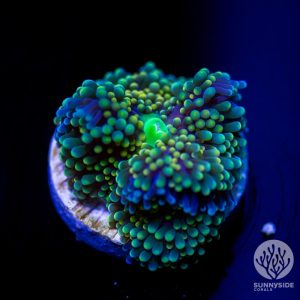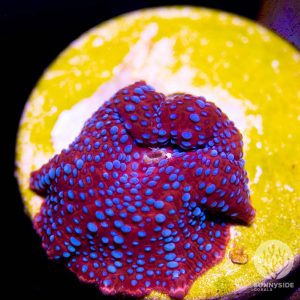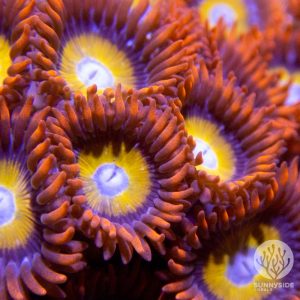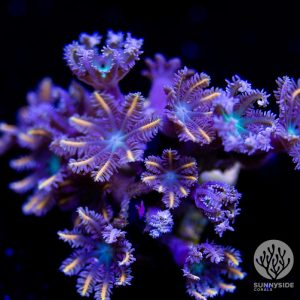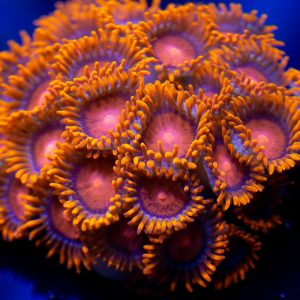What are Soft corals?
Soft coral, unlike hard corals, do not grow a hard carbonite skeletal structure. This allows soft corals to move and flow with the water movement. This type of coral is particularly popular with newer hobbyists because of its ease of care. Soft corals are not as susceptible to parameter changes in your water and often do better in a dirtier tank. this makes them the ideal choice for anyone testing out a new tank or looking for low-maintenance corals.
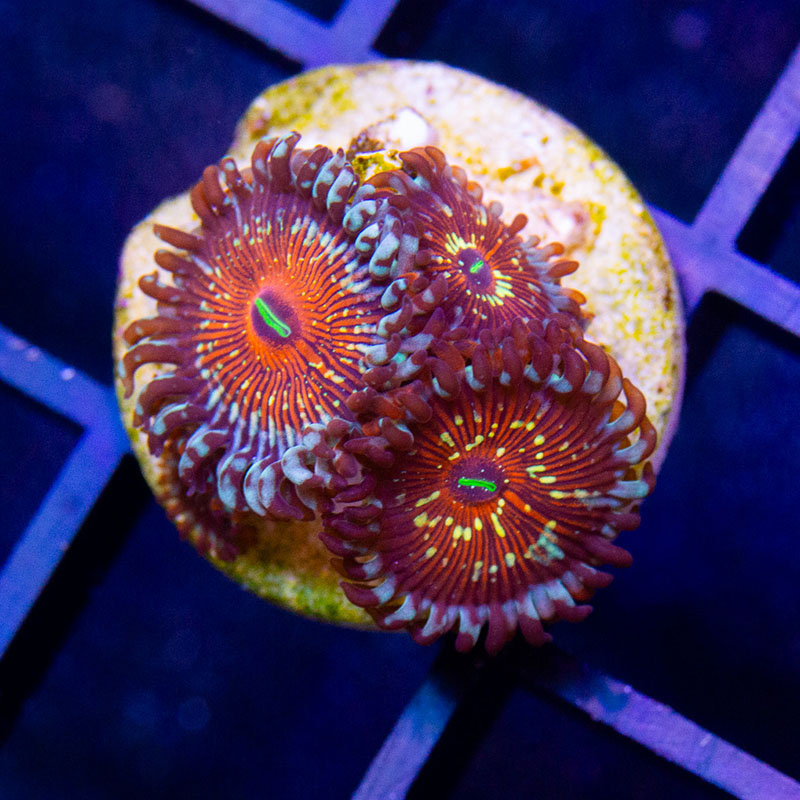
Clove Polyps
Fast-growing and hardy corals that add nice movement to any tank.
View All Clove Polyps
How To Care for Your Soft Coral
How much light do Soft corals need?
Soft corals can vary on how much light they require. Typically you want lower amounts of light and thrive at the bottom or sides of the tank where the light is not as direct. We run a slightly modified A/B schedule with gen 4 Radions and supplement T-5 lighting for all of our soft corals.
Flow Requirements
In general, this type of coral does best under low to medium amounts of flow. Be sure to research the specific type of coral that you are interested in to know how to best place it.
How to place Soft coral
When placing soft coral keep in mind the amount of flow and lighting that the coral will receive. You can always move the coral after a short period of time if it does not seem to be doing well. There is no perfect placement with any coral and each tank will be slightly different.
How to increase Soft coral growth
The key to increasing soft coral growth in your tank is to make sure your tank is consistent with higher nutrients. Once you find a spot in your tank where your corals are happy, don’t move them. If you keep your parameters consistent and have adequate light and flow, your soft corals will start to thrive. They also tend to do well in a slightly dirtier tank, meaning, it has slightly elevated Phosphates, Nitrates, and nutrients.
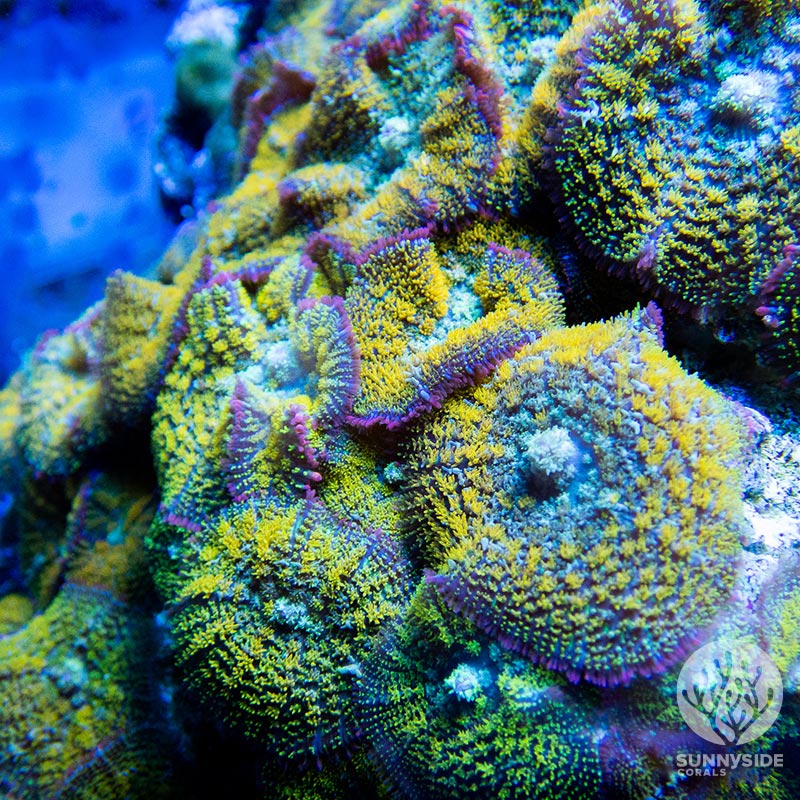
Things to Know Before You Buy Soft Coral
Soft corals are a great option for anyone getting into the hobby, starting a new tank or just doesn’t want to deal with the amount of upkeep that hard corals require. Soft corals can mostly be left alone with very little maintenance. They are very resistant to swings in tank parameters and do well in dirtier systems.
Another reason they are very popular is that they add movement to your tank. Because they do not have a rigid skeleton they are able to move with the flow of your tank. Be aware that some mushrooms or anemones like to move and it isn’t much you can do about it. Oftentimes they will choose a spot and stay but you never know.
Other important factors that play a role in the success of growing soft corals are the correct amount of lighting and flow. At Sunnyside Corals, we run a modified AB schedule with Gen 4 radions and supplement T-5 lighting on our LPS corals. Our soft corals typically grow best under lower light. Typically at the bottom of your tank or on the edges of your tank that are shaded are the best spots.
Overall soft corals are a great choice and can be very rewarding. Some types are touchier than others as well as have different growth rates. Please be aware of the needs of the specific type of soft coral when buying.
When can I add Soft coral to my tank?
Knowing when to start adding coral to your tank can be tricky. However, soft coral are the first type of coral that you will want to add to a new tank. Here are some of the key things to consider when thinking about adding Soft corals to your own tank.
Dry Rock
If you started your tank with dry rock you will most likely have to wait close to 3 months before you will be able to successfully keep soft coral alive. This is because dry rock can leach phosphate into the water for a very long time. Soft corals do well in slightly elevated Phosphate and Nitrate levels and will be a good option for you to test if your tank is ready and your parameters have stabilized.
Live Rock
If you started your tank with live rock that process can be dramatically shorter. However, be aware that just because your levels are where they should be, does not mean that your tank is actually ready for any corals. We recommend introducing LPS or Softy corals slowly and monitoring them closely with any new system. SPS corals should be the last type of coral that you try adding to any tank.
Softy Coral FAQs
Are soft corals easy to keep?
Soft corals are typically one of the easiest coral types to keep. They are perfect for beginners because they are more resilient to changes in your tank than other corals may not be.
Are soft corals aggressive?
Soft corals can be aggressive and typically need their space. There are many types of soft corals and not all are aggressive. For example, anemones are soft corals that will sting anything they get close to. Mushrooms, however, are not aggressive and can grow next to most corals without any issue.
Can soft corals move?
Most soft corals can and do move. Most soft corals have a foot that they use to attach themselves to the rock. Certain soft corals like mushrooms or anemones tend to move around until they find a spot that they like. The key to minimizing that is to place them in areas that meet their requirements such as low flow and medium lighting for most soft corals.
Can soft corals touch each other?
When placing soft coral, you should try to only have corals of the same species touching. Many corals, including most soft corals, will sting each other or release toxins to kill other types of corals that are too close.
What do soft coral eat?
Soft corals can be broad-fed or fed directly with something like a turkey baster. We broad feed our corals by feeding our fish a mix of frozen foods containing Mysis shrimp and pellet food.
Why do soft corals shrink?
Soft corals will shrink when there is either a sudden change around them like someone touching them or some other type of agitation. They may also shrink when they are receiving too much flow or not the right amount of lighting. Typically a soft coral will shrink up slightly and then extend back to its full size throughout the day.
What is considered a soft coral?
Soft corals can be recognized by their lack of calcium carbonate skeleton. They do not have any firm skeleton that keeps them in place but instead have soft growth structures.
Are soft corals good for beginners?
Soft corals are the perfect type of coral for beginners. Soft corals can mostly be left alone with very little maintenance. They are very resistant to swings in tank parameters and do well in dirtier systems.
Can you mix hard and soft corals?
Yes, you can mix hard and soft corals in a tank. Although, you need to make sure that each type of coral has its own space and has the right amount of flow and lighting. Generally, mixed tanks do very well.
When can I add soft corals to my tank?
Depending on if you start with dry rock or live rock, you can start to add soft corals to your tank in as little as one month up to three or four months. Each tank is different and has a different cycle time. Soft corals are the best corals to start out with any new tank though as they have the highest chance of survival.
How much light do soft corals need?
Soft corals can vary on how much light they require. Typically you want lower amounts of light and thrive at the bottom or sides of the tank where the light is not as direct. We run a slightly modified A/B schedule with gen 4 Radions and supplement T-5 lighting for all of our soft corals.
